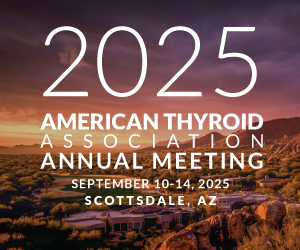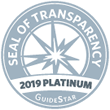
Advanced Radioactive Iodine Refractory-Differentiated Thyroid Cancer: Current Management Perspectives
Sarimar Agosto Salgado, MD
Moffitt Cancer Center
Tampa, Florida
September 23, 2022
The mainstays of therapy for differentiated thyroid cancer cases include surgery, selective use of radioactive iodine (RAI) based on risk of tumor recurrence, and TSH suppression therapy with levothyroxine[1]. Although most patients have a favorable prognosis, a subset develop distant metastases (<10%), of which approximately two-thirds result in radioactive iodine refractory differentiated thyroid cancer (RAIR-DTC) [2]. Depending on the extent of metastatic disease, active surveillance under TSH suppression and localized therapies, including surgery, radiation, ablative therapies, and bone modulating agents for bone metastases, may assist in controlling the disease. Nevertheless, patients may require long-term systemic treatment for progressive RAIR-DTC. Evaluation for systemic therapy includes radiographic staging (including brain imaging), tumor testing for targetable mutations, comprehensive laboratories, cardiac function assessment, and close monitoring of comorbidities such as hypertension, diabetes, etc.
Initial systemic therapies approved for RAIR-DTC included multikinase inhibitors (MKIs) Lenvatinib and Sorafenib, which target multiple tumorigenic kinase pathways, including vascular endothelial growth factor receptors. Lenvatinib demonstrated impressive response rates of 65% and survival improvement in patients 65 years and older, leading to FDA approval in 2015 [3-5]. However, since tumors almost inevitably develop resistance mechanisms, additional therapies are being studied to expand the management options for RAIR-DTC; for example, Cabozantinib has recently been approved as a second line MKI [6].
Improved understanding of the molecular pathogenesis of thyroid cancer, coupled with increasingly comprehensive molecular testing platforms, has led to new insights. In fact, molecular testing has developed over time into an informative tool for prognostic and therapeutic implications. For example, BRAF V600E is the most common alteration in papillary thyroid cancer (PTC), present in at least 60% of cases [7]. BRAF inhibitors alone (e.g., Dabrafenib) or in combination with a MEK inhibitor (e.g., Trametinib) have shown overall responses between 42-54% in RAIR-DTC [8, 9]. A recent FDA approval in the summer of 2022, supported dabrafenib and trametinib combination for unresectable or metastatic BRAF V600E solid tumors with progression despite prior treatments. In addition, recently approved selective inhibitor options include Selpercatinib and Pralsetinib for RET fusion-driven thyroid cancer, and Larotrectinib and Entrectinib for tumors harboring NTRK fusions. Together, both MKI’s and selective inhibitors have brought a ray of hope for patients with RAIR-DTC[10]. However, practice variability still exists in terms of a) timing of initiation of systemic therapy, b) the definition criteria for RAI-refractory thyroid cancer, and c) decision regarding the first line of therapy when a targetable mutation is present.
Selective targeted therapies balance efficacy and tolerability, leading to new potential approaches to manage advanced thyroid cancer. A promising new strategy leverages the discovery that BRAF V600E mutations can lead to alteration-dysfunction in the sodium-iodine symporter and contribute to the development of RAIR-DTC. A short course of BRAF-inhibitor therapy may result in redifferentiation in BRAF-altered tumors; this is a promising approach to resensitize tumors to RAI, allowing for discontinuation of systemic therapy post-RAI and thereby limiting the toxicities of long-term chemotherapy [11, 12]. Similar capacity for redifferentiation has been reported in RAS altered, NTRK, or RET fusion-driven thyroid cancers after the treatment with a MEK inhibitor, Larotrectinib, and Selpercatinib, respectively [13-16]. Further studies are needed to determine the optimal candidates by molecular signature, standardization of protocols, and appropriate timing to implement a redifferentiation approach.
As an oncologic endocrinologist, given the evolving landscape of therapeutic options for RAIR-DTC, it is essential to highlight the importance of timely evaluating patients with advanced thyroid cancer. High-risk thyroid cancer patients should be referred to expert multidisciplinary patient-centered teams; this ensures patients receive a comprehensive assessment to delineate treatment plans and incorporate the use of precision oncology.
References:
1. Haugen, B.R., et al., 2015 American Thyroid Association Management Guidelines for Adult Patients with Thyroid Nodules and Differentiated Thyroid Cancer: The American Thyroid Association Guidelines Task Force on Thyroid Nodules and Differentiated Thyroid Cancer. Thyroid, 2016. 26(1): p. 1-133.
2. Fullmer, T., M.E. Cabanillas, and M. Zafereo, Novel Therapeutics in Radioactive Iodine-Resistant Thyroid Cancer. Front Endocrinol (Lausanne), 2021. 12: p. 720723.
3. Schlumberger, M., et al., Lenvatinib versus placebo in radioiodine-refractory thyroid cancer. N Engl J Med, 2015. 372(7): p. 621-30.
4. Brose, M.S., et al., Effect of Age on the Efficacy and Safety of Lenvatinib in Radioiodine-Refractory Differentiated Thyroid Cancer in the Phase III SELECT Trial. J Clin Oncol, 2017. 35(23): p. 2692-2699.
5. Brose, M.S., et al., Sorafenib in radioactive iodine-refractory, locally advanced or metastatic differentiated thyroid cancer: a randomised, double-blind, phase 3 trial. Lancet, 2014. 384(9940): p. 319-28.
6. Brose, M.S., et al., Cabozantinib for radioiodine-refractory differentiated thyroid cancer (COSMIC-311): a randomised, double-blind, placebo-controlled, phase 3 trial. Lancet Oncol, 2021. 22(8): p. 1126-1138.
7. Landa, I., et al., Genomic and transcriptomic hallmarks of poorly differentiated and anaplastic thyroid cancers. J Clin Invest, 2016. 126(3): p. 1052-66.
8. Shah, M.H., et al., Results of randomized phase II trial of dabrafenib versus dabrafenib plus trametinib in BRAF-mutated papillary thyroid carcinoma. Journal of Clinical Oncology, 2017. 35(15_suppl): p. 6022-6022.
9. Busaidy, N.L., et al., Dabrafenib Versus Dabrafenib + Trametinib in BRAF-Mutated Radioactive Iodine Refractory Differentiated Thyroid Cancer: Results of a Randomized, Phase 2, Open-Label Multicenter Trial. Thyroid, 2022.
10. Cabanillas, M.E., M. Ryder, and C. Jimenez, Targeted Therapy for Advanced Thyroid Cancer: Kinase Inhibitors and Beyond. Endocr Rev, 2019. 40(6): p. 1573-1604.
11. Dunn, L.A., et al., Vemurafenib Redifferentiation of BRAF Mutant, RAI-Refractory Thyroid Cancers. J Clin Endocrinol Metab, 2019. 104(5): p. 1417-1428.
12. Rothenberg, S.M., et al., Redifferentiation of iodine-refractory BRAF V600E-mutant metastatic papillary thyroid cancer with dabrafenib. Clin Cancer Res, 2015. 21(5): p. 1028-35.
13. Groussin, L., J. Clerc, and O. Huillard, Larotrectinib-Enhanced Radioactive Iodine Uptake in Advanced Thyroid Cancer. N Engl J Med, 2020. 383(17): p. 1686-1687.
14. Lee, Y.A., et al., NTRK and RET fusion-directed therapy in pediatric thyroid cancer yields a tumor response and radioiodine uptake. J Clin Invest, 2021. 131(18).
15. Ho, A.L., et al., Selumetinib-enhanced radioiodine uptake in advanced thyroid cancer. N Engl J Med, 2013. 368(7): p. 623-32.
16. Jaber, T., et al., Targeted Therapy in Advanced Thyroid Cancer to Resensitize Tumors to Radioactive Iodine. J Clin Endocrinol Metab, 2018. 103(10): p. 3698-3705.
Disclaimer:
The ideas and opinions expressed on the ATA Blogs do not necessarily reflect those of the ATA. None of the information posted is intended as medical, legal, or business advice, or advice about reimbursement for health care services. The mention of any product, service, company, therapy or physician practice does not constitute an endorsement of any kind by ATA. ATA assumes no responsibility for any injury or damage to persons or property arising out of or related to any use of the material contained in, posted on, or linked to this site, or any errors or omissions.
For more information on Thyroid Topics please visit: https://www.thyroid.org/thyroid-information/
We invite you to submit any questions or comments regarding this blog post below, for potential response in a future blog or social media post.



